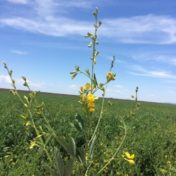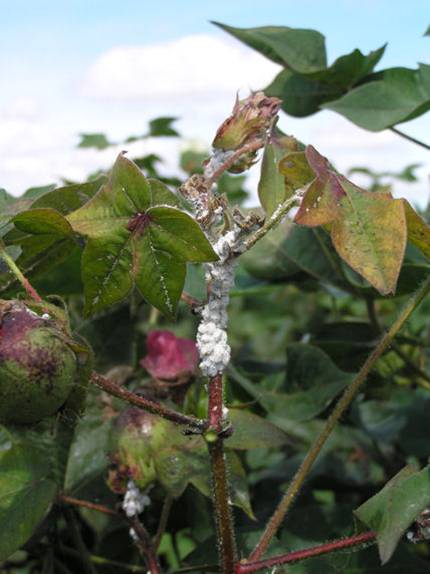With the current season shaping up to be one of high insect pressure, we may see silverleaf whitefly (SLW), Bemisia tabaci reach problematic levels in regions outside of their traditional range. For growers and agronomists not familiar with their control it is worth investing some time to understand how one of the main registered insecticides, pyriproxyfen, works. What is pyriproxyfen?… Read more »
Pigeon peas represent about 80% of the refuges cultivated to offset Bollgard cotton in Australia due to the land area use efficiency of this option. However, over the years, varietal mixing and continual recycling of seed from undamaged refuges has resulted in peas that flower later in the season, increasingly lacking synchrony with Bollgard’s boll setting period, thus reducing the… Read more »
Solenopsis mealybug can be found throughout Queensland’s cropping areas and has also been confirmed in Western Australia, the Northern Territory and Victoria. Whilst solenopsis has not yet been confirmed in NSW cotton crops it would be reasonable to assume that it is likely to be present in the broader landscape and it is only a matter of time before it… Read more »
Large flights of helicoverpa over the last 2 weeks (or longer in some districts) have seen significant eggs lays and larval populations in winter crops, including the winter cereals. It is not unusual to find both corn earworm and armyworm in cereal crops. Correct identification of the species present is very important as it influences damage potential and choice of… Read more »
Over the next few months, you have the opportunity to have weed seed collection and resistance testing undertaken on your farm by the Queensland Department of Agriculture and Fisheries (DAF). The Grain Research and Development Corporation (GRDC) has contracted DAF to undertake the survey of weeds and herbicide resistance on grain-producing farms throughout Queensland. The winter crop survey will… Read more »
A devastating disease was observed in several paddocks of soybean crops in the Branchview area of the Darling Downs in late autumn 2016. Almost 100 percent of plants were affected in some paddocks. The affected plants produced no, or very few filled pods and instead had a proliferation of tiny immature pods as shown in Photos 1 and 2. The plants… Read more »
Key points Conditions suitable for the usual cereal aphid species will also be suitable for RWA. Aphid populations typically build rapidly in late July and August. Do not assume aphids in cereals are just the usual oat and corn aphid. In the event of a Russian wheat aphid (RWA) infestation, early detection in spring is critical to prevent yield loss…. Read more »
Once again, lucerne crown borer (LCB) (Zygrita diva) has been active in soybeans this season. Worst affected regions were the Northern Rivers and the Liverpool Plains in NSW, but reports were also fielded from the Bundaberg, Fassifern and Darling Downs regions in Queensland. In some of the severely affected crops, over 80% of plants were infested, and up to 70%… Read more »
The National Management Group (NMG), comprising all Australian governments, Grain Producers Australia and Plant Health Australia, met on 8 June 2016 to discuss the incursion of Russian wheat aphid (Diuraphis noxia) in South Australia. Acting on advice from the Consultative Committee on Emergency Plant Pests (CCEPP), the NMG agreed that it is not technically feasible to eradicate Russian wheat aphid… Read more »
The South Australian government are currently responding to detections of Russian wheat aphid (Diuraphis noxia), which was initially found on a property in Tarlee in South Australia on 13 May 2106. Since the first detection, Russian wheat aphid has been found on a further 22 properties within 1,400 square kilometres, and the number is expected to rise. Investigations are underway… Read more »


